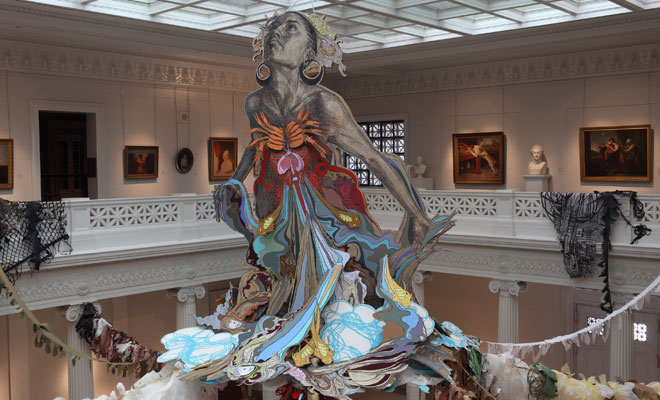From Street Wall to Great Hall: A Perceptual Shift

Swoon, Thalassa, 2011. Installation at the New Orleans Museum of Art. Photo by Judy Cooper. Courtesy the artist and the New Orleans Museum of Art.
Down on Poland Avenue there’s an empty building with a secret. Standing guard of that old corner store is a man made of parchment. Driving by, you would most likely miss him, but to the evening stroller his presence can spark a magical moment. Callie Curry, more commonly known as Swoon, wheatpasted this man along with a number of other pieces around New Orleans over the last three years. Each of these works creates a break in time into which the viewer can step out of his present-day reality and interact with his surroundings in an unexpected way.
How to create a moment rather than an object is one of the questions that Swoon has focused on in her art over the last decade. While still an art student at Pratt in Brooklyn, Swoon rejected the narrow assumption that an artist should make objects of consumption for gallery walls. She began to explore alternative possibilities to the institutional model, which led her to work outside, interacting with the forgotten spaces and crumbling bricks of New York City. Her newfound interaction with the city provided her with the realization that she could communicate with a far greater number of viewers simply by pasting an image on the street. For example, once, while checking on a work, Swoon was approached by a woman who lived nearby. The woman told her the story of another neighbor, who was mentally handicapped and had discovered the wheatpasted piece. He had begun calling it his secret and sharing it with everyone who walked by him on the block. Swoon noted in an interview: “By putting a tiny change in the environment I realized I could change the associations people have and create an opportunity for connections between people. Maybe there are slightly different worlds existing right where we are and we just have to have a perceptual shift to see it.”
Created in unanticipated places, Swoon’s pieces live in the gap between reality and imagination, colliding the two worlds. The imagination is sparked, the mind begins its travel, and yet the viewer is still left standing on the street next to a broken fence or empty parking lot. This brief moment of convergence and disorientation is how Swoon’s street pieces gain their power. When one enters a museum, however, the expectation of seeing art is already present, hindering the surprise confrontation. How then does Swoon’s Thalassa function when placed in the Great Hall of the New Orleans Museum of Art?
Cultural anthropologist Victor Turner wrote: “I see liminality as a phase in social life in which this confrontation between ‘activity which has no structure’ and its ‘structured results’ produces in men their highest pitch of self-consciousness.” Though rooted in theories of social ritual and rites of passage, this idea could also be applied to works of art. Swoon’s street pieces bridge the divide between sites previously unassociated with art and the structured art world. Her experience working outside the institution, striving to create a liminal space for art to live, allows Swoon to retain a vibrant and palpable energy in a work like Thalassa even when presented in the Great Hall. The sea goddess looks as if she is about to burst through the museum’s ceiling, leaving behind only shattered glass and delicate tendrils of tissue paper. Her long tentacles, dripping with Spanish moss-like appendages, reach out to the second floor balcony. Thalassa is dreamlike, a magical mess of paper and paint that makes the viewer feel like a child playing in a castle of pillows. It maintains inside that singular quality that makes Swoon’s street pieces so appealing: the possibility of other realities.

Scene by Swoon located on Piety Street between St. Claude Avenue and Rampart Street in New Orleans. Photo by Tori Bush.
Editor's Note
“Swoon: Thalassa” on view through September 25, 2011 at the New Orleans Museum of Art.



